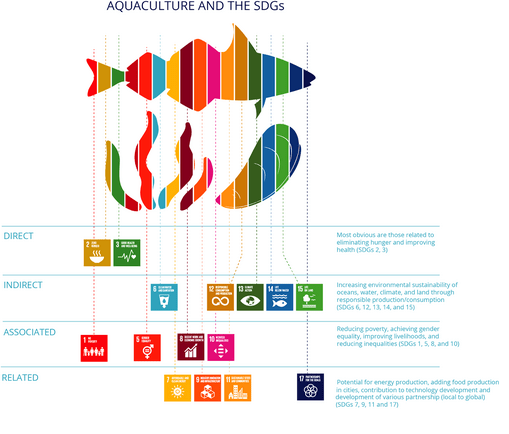
Aquaculture is considered a key player in achieving the United Nations Sustainable Development Goals (SDGs), particularly those related to food security (SDG 2), climate change (SDG 13), and biodiversity (SDG 14), collectively known as FCB (Food, Climate, Biodiversity). But can the aquaculture industry truly fulfill this promise? According to a new study, the answer is a promising “maybe.”
The study, published by researchers from the Institute for the Oceans and Fisheries at the University of British Columbia (Canada), emphasizes biological diversity. Different aquatic species possess unique traits that can benefit each goal in various ways. While many studies have focused on increasing aquaculture production in general, this research takes a novel approach. It examines the specific biological attributes of farmed species and how they relate to achieving the three FCB goals simultaneously.
Using cutting-edge techniques
The researchers conducted a systematic review of existing literature. This means they meticulously analyzed a wide range of scientific studies to identify key traits associated with each FCB goal. To compile a list of traits of cultivated aquatic species associated with food security, climate change, and biodiversity, they conducted a qualitative systematic review of scientific literature.
The scientists then employed fuzzy logic, a powerful tool that accommodates uncertainty and variability. Imagine a spectrum from “good” to “bad” for a trait like growth rate. While some species may be excellent producers, others may be average. Fuzzy logic accounts for this by assigning membership levels to each category, providing a more nuanced picture.
This approach addresses the challenge of limited data on some traits. It also considers natural variations within a species, leading to more informed decisions about which species to cultivate for a sustainable future.
Food security takes the lead
The potential of aquaculture to address food security is undeniable. It offers a way to increase the supply of fish, especially when wild fish populations struggle to meet demand. This is particularly critical for vulnerable communities that rely on fish for both nutrition and income. By focusing on producing nutritious aquatic food, aquaculture can directly contribute to SDG 2, helping to eliminate hunger and malnutrition.
The study revealed that most of the identified traits are related to food security. But here’s the interesting part: a significant portion (two-thirds) of these food security-related traits also connect with climate change or biodiversity. This suggests that by optimizing a single trait, we can potentially achieve co-benefits for multiple goals.
Challenges and opportunities: A balancing act
The research also identified interesting correlations between FCB indices. These correlations imply that the challenges and opportunities in aquaculture are intertwined across the three goals. However, the study found that average FCB scores for most species were relatively low. This suggests that focusing solely on increasing production may not be enough to achieve true sustainability.
Stay Always Informed
Join our communities to instantly receive the most important news, reports, and analysis from the aquaculture industry.
Beyond the big fish
Interestingly, the study found that species typically associated with high food production, particularly fish, often scored low on the combined FCB scale. In contrast, algae and mollusk species tended to perform well across all FCB indices. This highlights the importance of exploring species beyond traditional fish farming and the potential benefits of integrated multi-trophic aquaculture systems that combine different species.
Guiding the future of sustainable aquaculture
The research provides valuable insights for decision-makers in the aquaculture industry. By understanding the biological traits that contribute to achieving FCB goals, we can select and cultivate species that promote a more sustainable food system. This knowledge can also inform strategies to increase support for FCB-positive aquaculture practices, considering the specific regional contexts where these practices are implemented.
The road ahead
“The study provides decision-makers with a biologically informed assessment of desirable aquaculture traits and species, while illuminating potential strategies to increase support for FCB goals,” the scientists concluded.
Furthermore, the study lays the groundwork for future research. Future investigations can explore the socio-economic opportunities and barriers associated with transitioning aquaculture practices towards a more sustainable model. This will pave the way for developing equitable pathways that achieve positive FCB outcomes in diverse regions worldwide.
Ultimately, aquaculture holds great promise for contributing to a sustainable food system. By harnessing the power of biological diversity and adopting a holistic approach that considers the three FCB goals, we can unlock the true potential of the aquaculture industry for the benefit of our planet and its people.
The study was funded by the National Science and Engineering Research Council of Canada (Canada Graduate Scholarships–Master’s) and the Social Sciences and Humanities Research Council of Canada.
Contact
Aleah Wong
Institute for the Oceans and Fisheries, The University of British Columbia
Vancouver, BC, Canada
Email: a.wong@oceans.ubc.ca
Reference (open access)
Wong, A., Frommel, A. Y., Sumaila, U. R., & Cheung, W. W. (2024). A traits-based approach to assess aquaculture’s contributions to food, climate change, and biodiversity goals. Npj Ocean Sustainability, 3(1), 1-13. https://doi.org/10.1038/s44183-024-00065-7
Editor at the digital magazine AquaHoy. He holds a degree in Aquaculture Biology from the National University of Santa (UNS) and a Master’s degree in Science and Innovation Management from the Polytechnic University of Valencia, with postgraduate diplomas in Business Innovation and Innovation Management. He possesses extensive experience in the aquaculture and fisheries sector, having led the Fisheries Innovation Unit of the National Program for Innovation in Fisheries and Aquaculture (PNIPA). He has served as a senior consultant in technology watch, an innovation project formulator and advisor, and a lecturer at UNS. He is a member of the Peruvian College of Biologists and was recognized by the World Aquaculture Society (WAS) in 2016 for his contribution to aquaculture.



